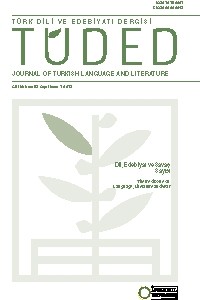Eski Uygurca, Partça ve Orta Farsça Bir Yazmanın Rekonstrüksiyon Çalışması
Turfan Yazmaları, Kodikoloji, Fragmentoloji, Rekonstrüksiyon, Manihaizm
A Reconstruction Study of an Old Uyghur, Parthian, and Middle Persian Manuscript
Turfan manuscripts, codicology, fragmentology, reconstruction, Manichaeism,
___
- Asmussen, J. P. (1965). Xuästvämft: studies in Manichaeism. Copenhagen: Prostant Apud Munksgaard. (Acta Theologica Danica 12) google scholar
- Bang-Kaup, W. (1923). Manichaeische Laien-Beichtspiegel. Le Muséon, (36): 137-242. google scholar
- Boyce, M. (1954). The Manichaean hymn-cycles in Parthian. London: Oxford University Press. google scholar
- Boyce, M. (1960). A catalogue of the Iranian manuscripts in Manichean script in the German Turfan Collection. Berlin: Akademie Verlag. (DAW. Institut für Orientforschung. 45.) google scholar
- Clark, L. (2013). Uygur Manichaean texts. Volume ii: liturgical texts. Text, translation, commentary. Turnhout: Brepols. (Corpus fontium Manichaeorum. Series Turcica 2) google scholar
- Franck, R. R. (2005). Bast and other plant fibres. Cambridge: Woodhead Publishing. google scholar
- Gulásci, Zs. (2005). Mediaeval Manichaean book art. Leiden-Boston: Brill. (NHMS 57) google scholar
- Helman-Wazny, A. (2020). Notes on the early history of paper in Central Asia based on material evidence. The studies into the history of the book and book collections. (14/3): 341- 366. google scholar
- Klimkeit, H.-J. (1993). Gnosis on the Silk Road: Gnostic texts from Central Asia, San Francisco: HarperOne. google scholar
- Le Coq, A. von (1911). Chuastuanift, ein Sündenbekenntnis der manichäischen auditores, gefunden in google scholar
- Turfan (Chinesisch-Turkistan). Berlin: Akademie Verlag. AKPAW. Phil.-hist. Cl. 1910. (Anhang: Abhandlungen nicht zur Akademie gehöriger Gelehrter. 4) [Tıpkıbasım: SEDTF 1, 564-604] google scholar
- Lowden, J. (1992). The octateuchs: a study in Byzantine manuscript illumination. Pennsylvania: Penn State University Press. google scholar
- McCarthy, J. (2018). Paper and papermaking. The encyclopedia of Greater Philadelphia. Erişim tarihi: 22/08/22. https://philadelphiaencyclopedia.org/essays/paper-and- papermaking/ google scholar
- Özbay, B. (2019). Huastuanift Manihaist uygurların tövbe duası. Ankara: Türk Dil Kurumu Yayınları. (AKDTYK TDK 1127. Eski Uygurca Kütüphanesi 3.) (1. baskı 2014) google scholar
- Özbay, B. (2020). Manihaist bir ilahiHuyadagmän: Partça, Soğdca, Eski Uygurca metin ve çeviri. İstanbul: Dergâh Yayınları. (Dil ve Dil Bilimi Dizisi. 3) google scholar
- Tekin, Ş. (1993). Eski Türklerdeyazı, kâğıt, kitap ve kâğıt damgaları. İstanbul: Dergâh Yayınları. google scholar
- Tugusheva, L. Yu. (2008). Xuastuanift (Manichaean confession of sins), facsimile edition preface, transcription of the Uighur text. Translation by L. Yu. Tugusheva Comments by A. L. Khosroyev. St. Petersburg: Nestor-Historia. google scholar
- Wiesner, J. (1887). Die Faijûmer und Uschmûner Papiere. Eine naturwissenschaftliche, mit Rücksicht auf die Erkennung alter und moderner Papiere und auf die Entwicklungder Papierbereitung durchgeführte Untersuchung. Mittheilungen aus der Sammlung der Papyrus Erzherzog Rainer (2-3): 179-260. google scholar
- Wilkens, J. (2000). Alttürkische Handschriften. Teil 8. Manichäisch-türkische Texte der Berliner Turfansammlung. Stuttgart: Franz Steiner Verlag. (VOHD 13, 16) google scholar
- Zieme, P. (1966/7). Beiträge zur Erforschung des Xvastvanift. MIO (12): 351-378. google scholar
- ISSN: 1015-2091
- Başlangıç: 1946
- Yayıncı: İstanbul Üniversitesi
Eski Uygurcada Budizm’e Ait Bir Ritüel: Bakçan Olur-
Her Şey Değişirken: Şeyh Mehmed Raşid Efendi ve “Sırf Türkçe” Mevlidi
İstiğrak, Saṃsāra ve Tövbe: Türlü Meselelere İlişkin Eski Uygurca Metin Parçaları
Jungian Edebiyat Eleştirisi Bağlamında Cemal Süreya Şiirinde Kendini Gerçekleştirme Biçimleri
Peri Masalı, Eşitsizlikler ve “Eşit Masallar”
Yasemin BAYRAKTAR, Sevim İNAL, Oya TUNABOYLU
Süleyman DOĞAN, Lütfullah ÇELİKTEN
Mevlid-i Fâtıma’da Elma Yiyerek Hamile Kalma Motifi
